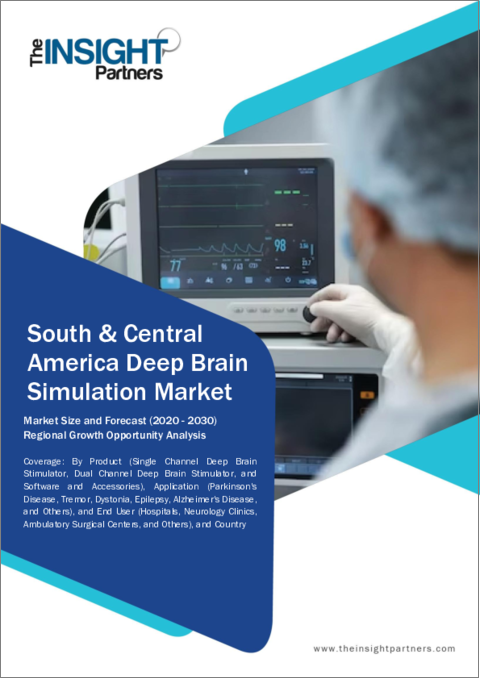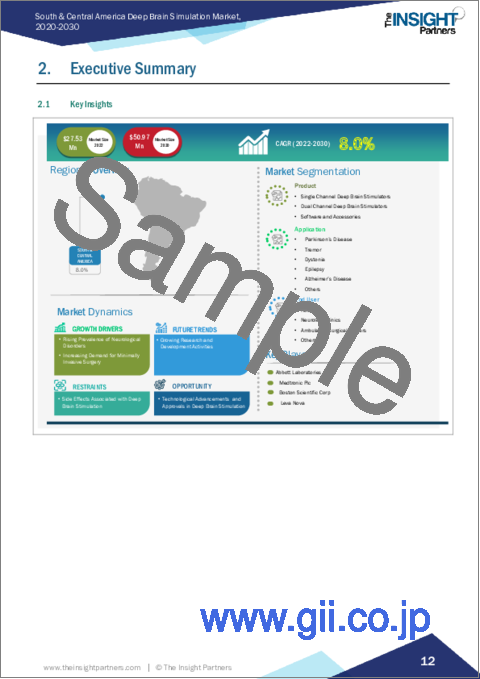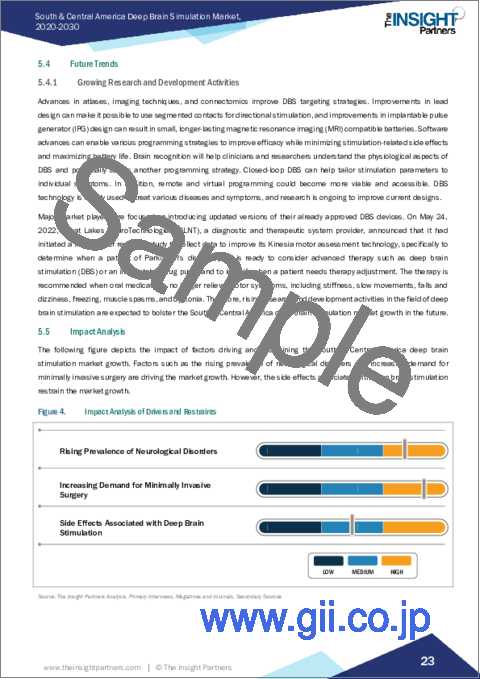|
|
市場調査レポート
商品コード
1452614
中南米の脳深部刺激療法市場の2030年までの予測-地域別分析-製品別、用途別、エンドユーザー別South & Central America Deep Brain Simulation Market Forecast to 2030 - Regional Analysis - by Product, Application, and End User |
||||||
|
|||||||
| 中南米の脳深部刺激療法市場の2030年までの予測-地域別分析-製品別、用途別、エンドユーザー別 |
|
出版日: 2024年01月15日
発行: The Insight Partners
ページ情報: 英文 79 Pages
納期: 即納可能
|
全表示
- 概要
- 図表
- 目次
中南米の脳深部刺激療法市場は、2022年の2,753万米ドルから2030年には5,095万米ドルに成長すると予測されています。2022年から2030年までのCAGRは8.0%で成長すると推定されます。
低侵襲手術の需要増加が中南米脳深部刺激療法市場を牽引
脳深部刺激は、ジストニア、パーキンソン病、本態性振戦などの運動障害の治療に用いられる低侵襲標的手術です。低侵襲手術(MIS)には、従来の手術法に比べていくつかの利点があります。MISは身体への外傷を最小限に抑え、術後の痛みを軽減し、回復速度を速め、治療成績を向上させる。ロボット手術は低侵襲手術における最新の進化であり、従来の腹腔鏡手術で使用されていたのと同じ小さな切開創を使用する精密機器を外科医に提供します。MISは開腹手術に比べて出血量が少なく、鎮痛剤の使用量も少なく、術後の入院期間も短いです。さらに、低侵襲手術は従来の手術法よりも高い正確率を示しています。また、これらの手術では、細い管やカメラを挿入するのに十分な大きさの小さな切開が必要です。MISのこうした利点は入院患者を増やし、高い手術罹患率と死亡率に直面する高齢患者に手術を求めるよう促しています。このように、低侵襲手術の利点による需要の高まりが、中南米の脳深部刺激療法市場の成長を後押ししています。
中南米脳深部刺激療法市場概要
ブラジルでは高齢化人口が急速に増加しています。汎米保健機構(PAHO)のデータによると、ブラジルの60歳以上の人口は3,000万人を超え、同国の人口の13%を占める。2030年には、この年齢層は5,000万人に達し、ブラジル人口の24%を占めると予想されています。ブラジル統計研究所によると、2050年までに65歳以上の人口がブラジル総人口の36%を占めると予想されています。さらに、神経疾患の有病率はブラジルの高齢者人口に依存しているため、パーキンソン病やアルツハイマー病などの神経疾患の罹患率の増加は、治療のための脳深部刺激療法の需要を促進する可能性が高いです。さらに、2023年に発表された研究「Trends in mortality from Alzheimer's disease in Brazil, 2000-2019」によると、ブラジルでは、死亡率の増加や有病率の上昇と相まって高齢化が進んでいるため、アルツハイマー病が健康上の大きな問題となっています。2009年から2019年にかけて、同国ではアルツハイマー病による死亡が49%増加し、死因の第7位となりました。ブラジルの同期間の死因は21万1,600人以上でした。さらに、死亡者の73%が80歳以上、27%が60~79歳でした。したがって、上記の要因により、今後数年間、同国における疾患治療のための脳深部刺激療法機器の需要が増加すると予想されます。
中南米脳深部刺激療法市場の収益と2030年までの予測(金額)
中南米の脳深部刺激療法市場セグメンテーション
中南米の脳深部刺激療法市場は、製品、用途、エンドユーザー、国に区分されます。
製品別では、中南米の脳深部刺激療法市場は、シングルチャンネル脳深部刺激装置、デュアルチャンネル脳深部刺激装置、ソフトウェアとアクセサリーに区分されます。2022年には、デュアルチャンネル脳深部刺激装置セグメントが中南米脳深部刺激療法市場で最大のシェアを記録しました。
用途別では、中南米脳深部刺激療法市場は、パーキンソン病、振戦、ジストニア、てんかん、アルツハイマー病、その他に区分されます。2022年には、パーキンソン病セグメントが中南米脳深部刺激療法市場で最大のシェアを記録しました。
エンドユーザー別に見ると、中南米の脳深部刺激療法市場は病院、神経科クリニック、外来手術センター、その他に区分されます。2022年には、病院セグメントが南米脳深部刺激療法市場で最大のシェアを記録しました。
国別では、中南米の脳深部刺激療法市場は、ブラジル、アルゼンチン、その他の南米に区分されます。2022年には、ブラジルが中南米脳深部刺激療法市場で最大のシェアを記録しました。
Abbott、Medtronic、Boston Sci、Leva Novaは、中南米の脳深部刺激療法市場で事業を展開している大手企業です。
目次
第1章 イントロダクション
第2章 エグゼクティブサマリー
- 主要洞察
- 中南米の脳深部刺激療法市場:国別
第3章 調査手法
- 調査範囲
- 2次調査
- 1次調査
第4章 中南米脳深部刺激療法市場情勢
- イントロダクション
- 中南米PEST分析
- 比較分析
- 脳深部刺激療法と病変形成手技の比較
- 神経疾患における病変形成手順
- 中南米脳深部刺激術と病変部位の手術2022年:件数別
- 2022年に実施された中南米脳深部刺激術の手術手技数:国別
第5章 南米と中米の脳深部刺激市場:主要産業力学
- 主要市場の促進要因
- 神経疾患の有病率の上昇
- 低侵襲手術に対する需要の増加
- 市場抑制要因
- 脳深部刺激療法に伴う副作用
- 市場機会
- 脳深部刺激療法における技術の進歩と承認
- 今後の動向
- 研究開発の活発化
- 影響分析
第6章 脳深部刺激市場:中南米市場分析
- 中南米の脳深部刺激市場売上実績、2022~2030年
第7章 中南米脳深部刺激療法市場~2030年までの収益と予測:製品別
- イントロダクション
- 2022年と2030年の中南米脳深部刺激市場売上高シェア(%):製品別
- シングルチャンネル脳深部刺激装置
- デュアルチャンネル脳深部刺激装置
- ソフトウェアと付属品
第8章 中南米脳深部刺激市場:収益と2030年までの予測:用途別
- イントロダクション
- 中南米脳深部刺激療法市場2022年・2030年売上高シェア(%):用途別
- パーキンソン病
- 振戦
- アルツハイマー病
- ジストニア
- てんかん
- その他
第9章 中南米脳深部刺激療法市場:収益と2030年までの予測:エンドユーザー別
- イントロダクション
- 2022年と2030年の中南米脳深部刺激療法市場売上高シェア(%):エンドユーザー別
- 病院
- 神経クリニック
- 外来手術センター
- その他
第10章 中南米の脳深部刺激療法市場:国別分析
- 概要
- 中南米の脳深部刺激療法市場:国別一覧
- ブラジル
- アルゼンチン
- その他の中南米
第11章 中南米の脳深部刺激療法市場業界情勢
- イントロダクション
- 脳深部刺激療法市場の成長戦略
- 有機的成長戦略
- 概要
- 無機的成長戦略
- 概要
第12章 中南米脳深部刺激療法市場:主要企業プロファイル
- Abbott Laboratories
- Medtronic Plc
- Boston Scientific Corp
- LivaNova Plc
第13章 付録
List Of Tables
- Table 1. South & Central America Deep Brain Simulation Market Segmentation
- Table 2. Comparison of Deep Brain Stimulation and Lesioning Procedures
- Table 3. South & Central America Deep Brain Stimulation Surgeries and Lesion Surgeries Volume in 2022
- Table 4. South & Central America Deep Brain Stimulation Surgical Procedures Performed in 2022, by Country.
- Table 5. Brazil Deep Brain Simulation Market Revenue and Forecast to 2030 (US$ Mn) - Product
- Table 6. Brazil Deep Brain Simulation Market Revenue and Forecast to 2030 (US$ Mn) - Application
- Table 7. Brazil Deep Brain Simulation Market Revenue And Forecast to 2030 (US$ Mn) - End User
- Table 8. Argentina Deep Brain Simulation Market Revenue and Forecast to 2030 (US$ Mn) - Product
- Table 9. Argentina Deep Brain Simulation Market Revenue And Forecast to 2030 (US$ Mn) - Application
- Table 10. Argentina Deep Brain Simulation Market Revenue And Forecast to 2030 (US$ Mn) - End User
- Table 11. Rest of South & Central America Deep Brain Simulation Market Revenue and Forecast to 2030 (US$ Mn) - Product
- Table 12. Rest of South & Central America Deep Brain Simulation Market Revenue and Forecast to 2030 (US$ Mn) - Application
- Table 13. Rest of South & Central America Deep Brain Simulation Market Revenue and Forecast to 2030 (US$ Mn) - End User
- Table 14. Recent Organic Growth Strategies in Deep Brain Stimulation Market
- Table 15. Recent Inorganic Growth Strategies in the Deep Brain Stimulation Market
- Table 16. Glossary of Terms, South & Central America Deep Brain Simulation Market
List Of Figures
- Figure 1. South & Central America Deep Brain Simulation Market Segmentation, By Country
- Figure 2. South & Central America - PEST Analysis
- Figure 3. South & Central America Deep Brain Simulation Market - Key Industry Dynamics
- Figure 4. Impact Analysis of Drivers and Restraints
- Figure 5. South & Central America Deep Brain Simulation Market Revenue (US$ Mn), 2022 - 2030
- Figure 6. South & Central America Deep Brain Simulation Market Revenue Share, by Product 2022 & 2030 (%)
- Figure 7. Single Channel Deep Brain Stimulator: South & Central America Deep Brain Simulation Market - Revenue and Forecast to 2030 (US$ Million)
- Figure 8. Dual Channel Deep Brain Stimulator: South & Central America Deep Brain Simulation Market - Revenue and Forecast to 2030 (US$ Million)
- Figure 9. Software and Accessories: South & Central America Deep Brain Simulation Market - Revenue and Forecast to 2030 (US$ Million)
- Figure 10. South & Central America Deep Brain Simulation Market Revenue Share, by Application 2022 & 2030 (%)
- Figure 11. Parkinson\'s Disease: South & Central America Deep Brain Simulation Market - Revenue and Forecast to 2030 (US$ Million)
- Figure 12. Tremor: South & Central America Deep Brain Simulation Market - Revenue and Forecast to 2030 (US$ Million)
- Figure 13. Alzheimer\'s Disease: South & Central America Deep Brain Simulation Market - Revenue and Forecast to 2030 (US$ Million)
- Figure 14. Dystonia: South & Central America Deep Brain Simulation Market - Revenue and Forecast to 2030 (US$ Million)
- Figure 15. Epilepsy: South & Central America Deep Brain Simulation Market - Revenue and Forecast to 2030 (US$ Million)
- Figure 16. Others: South & Central America Deep Brain Simulation Market - Revenue and Forecast to 2030 (US$ Million)
- Figure 17. South & Central America Deep Brain Simulation Market Revenue Share, by End User 2022 & 2030 (%)
- Figure 18. Hospitals: South & Central America Deep Brain Simulation Market - Revenue and Forecast to 2030 (US$ Million)
- Figure 19. Neurology Clinics: South & Central America Deep Brain Simulation Market - Revenue and Forecast to 2030 (US$ Million)
- Figure 20. Ambulatory Surgical Centers: South & Central America Deep Brain Simulation Market - Revenue and Forecast to 2030 (US$ Million)
- Figure 21. Others: South & Central America Deep Brain Simulation Market - Revenue and Forecast to 2030 (US$ Million)
- Figure 22. South & Central America Deep Brain Simulation Market, By Country, 2022 ($Mn)
- Figure 23. South & Central America Deep Brain Simulation Market, By Key Countries, 2022 And 2030 (%)
- Figure 24. Brazil Deep Brain Simulation Market Revenue and Forecast to 2030 (US$ Mn)
- Figure 25. Argentina Deep Brain Simulation Market Revenue and Forecast to 2030 (US$ Mn)
- Figure 26. Rest of South & Central America Deep Brain Simulation Market Revenue and Forecast to 2030 (US$ Mn)
- Figure 27. Growth Strategies in Deep Brain Stimulation Market
The South & Central America deep brain simulation market is expected to grow from US$ 27.53 million in 2022 to US$ 50.95 million by 2030. It is estimated to grow at a CAGR of 8.0% from 2022 to 2030.
Increasing Demand for Minimally Invasive Surgery Drive South & Central America Deep Brain Simulation Market
Deep brain stimulation is a minimally invasive targeted surgery used to treat movement disorders in dystonia, Parkinson's disease, and essential tremor. Minimally invasive surgeries (MIS) offer several advantages over traditional surgical techniques. MIS minimizes trauma to the body, reduces postoperative pain, increases recovery speed, and improves outcomes. Robotic procedures represent the latest evolution in minimally invasive procedures, providing surgeons with precision equipment that uses the same small incisions used in traditional laparoscopy. MIS leads to less blood loss, less analgesic use, and shorter postoperative hospital stay than open surgery. In addition, minimally invasive surgery indicates a higher accuracy rate than traditional surgical methods. Also, these procedures require tiny incisions large enough to insert thin tubes and cameras. These benefits of MIS are increasing inpatients and have encouraged older patients who face high operative morbidity and mortality to seek surgery. Thus, the rising demand for minimally invasive surgeries due to their advantages bolsters the South & Central America deep brain stimulation (DBS) market growth.
South & Central America Deep Brain Simulation Market Overview
In Brazil, the aging population is rapidly growing. According to the data from Pan American Health Organization (PAHO), Brazil has over 30 million people aged 60 years and older, representing 13% of the country's population. By 2030, this age group is expected to reach ~50 million, representing 24% of the Brazilian population. As per the Brazil Statistical Institute, the country's population aged 65 and above is expected to hold 36% share of the total population of Brazil by 2050. Further, the prevalence of neurological disorders is dependent on the geriatric population in Brazil; thus, the increasing incidences of neurological diseases, such as Parkinson's disease and Alzheimer's disease, are likely to propel the demand for deep brain stimulation (DBS) for treatment. Moreover, as per the study, "Trends in mortality from Alzheimer's disease in Brazil, 2000-2019," published in 2023, in Brazil, Alzheimer's disease has become a major health concern since the population is increasingly aging, coupled with the increasing mortality rates and the growing prevalence of the disease in the country. During 2009-2019, there was a 49% increase in deaths due to Alzheimer's disease in the country, making it the seventh leading cause of death. More than 211,600 deaths were due to the disease in the same period in Brazil. Furthermore, 73% of the deaths were of people aged 80 and above, and 27% were in the 60-79 age group. Thus, the above-mentioned factors are expected to increase the demand for DBS devices for the treatment of diseases in the country in the coming years.
South & Central America Deep Brain Simulation Market Revenue and Forecast to 2030 (US$ Million)
South & Central America Deep Brain Simulation Market Segmentation
The South & Central America deep brain simulation market is segmented into product, application, end user, and country.
Based on product, the South & Central America deep brain simulation market is segmented into single channel deep brain stimulator, dual channel deep brain stimulator, and software and accessories. In 2022, the dual channel deep brain stimulator segment registered the largest share in the South & Central America deep brain simulation market.
Based on application, the South & Central America deep brain simulation market is segmented into Parkinson's disease, tremor, dystonia, epilepsy, Alzheimer's disease, and others. In 2022, the Parkinson's disease segment registered the largest share in the South & Central America deep brain simulation market.
Based on end user, the South & Central America deep brain simulation market is segmented into hospitals, neurology clinics, ambulatory surgical centers, and others. In 2022, the hospitals segment registered the largest share in the South & Central America deep brain simulation market.
Based on country, the South & Central America deep brain simulation market is segmented into Brazil, Argentina, and the Rest of South & Central America. In 2022, Brazil registered the largest share in the South & Central America deep brain simulation market.
Abbott, Medtronic, Boston Sci, and Leva Nova are some of the leading companies operating in the South & Central America deep brain simulation market.
Table Of Contents
1. Introduction
- 1.1 The Insight Partners Research Report Guidance
- 1.2 Market Segmentation
2. Executive Summary
- 2.1 Key Insights
- 2.2 South & Central America Deep Brain Stimulation Market, by Country (US$ Million)
3. Research Methodology
- 3.1 Coverage
- 3.2 Secondary Research
- 3.3 Primary Research
4. South & Central America Deep Brain Simulation Market Landscape
- 4.1 Overview
- 4.2 South & Central PEST Analysis
- 4.3 Comparison Analysis
- 4.3.1 Comparison of Deep Brain Stimulation and Lesioning Procedures
- 4.3.2 Lesioning Procedures in Neurological Disorders
- 4.3.3 South & Central America Deep Brain Stimulation and Lesion Surgeries 2022, By Volume
- 4.3.4 South & Central America Deep Brain Stimulation Surgical Procedures Performed in 2022, By Country
5. South & Central America Deep Brain Simulation Market - Key Industry Dynamics
- 5.1 Key Market Drivers:
- 5.1.1 Rising Prevalence of Neurological Disorders
- 5.1.2 Increasing Demand for Minimally Invasive Surgery
- 5.2 Market Restraints
- 5.2.1 Side Effects Associated with Deep Brain Stimulation
- 5.3 Market Opportunities
- 5.3.1 Technological Advancements and Approvals in Deep Brain Stimulation
- 5.4 Future Trends
- 5.4.1 Growing Research and Development Activities
- 5.5 Impact Analysis
6. Deep Brain Simulation Market - South & Central America Market Analysis
- 6.1 South & Central America Deep Brain Simulation Market Revenue (US$ Mn), 2022 - 2030
7. South & Central America Deep Brain Simulation Market - Revenue and Forecast to 2030 - by Product
- 7.1 Overview
- 7.2 South & Central America Deep Brain Simulation Market Revenue Share, by Product 2022 & 2030 (%)
- 7.3 Single Channel Deep Brain Stimulator
- 7.3.1 Overview
- 7.3.2 Single Channel Deep Brain Stimulator: South & Central America Deep Brain Simulation Market - Revenue and Forecast to 2030 (US$ Million)
- 7.4 Dual Channel Deep Brain Stimulator
- 7.4.1 Overview
- 7.4.2 Dual Channel Deep Brain Stimulator: South & Central America Deep Brain Simulation Market - Revenue and Forecast to 2030 (US$ Million)
- 7.5 Software and Accessories
- 7.5.1 Overview
- 7.5.2 Software and Accessories: South & Central America Deep Brain Simulation Market - Revenue and Forecast to 2030 (US$ Million)
8. South & Central America Deep Brain Simulation Market - Revenue and Forecast to 2030 - by Application
- 8.1 Overview
- 8.2 South & Central America Deep Brain Simulation Market Revenue Share, by Application 2022 & 2030 (%)
- 8.3 Parkinson\'s Disease
- 8.3.1 Overview
- 8.3.2 Parkinson\'s Disease: South & Central America Deep Brain Simulation Market - Revenue and Forecast to 2030 (US$ Million)
- 8.4 Tremor
- 8.4.1 Overview
- 8.4.2 Tremor: South & Central America Deep Brain Simulation Market - Revenue and Forecast to 2030 (US$ Million)
- 8.5 Alzheimer\'s Disease
- 8.5.1 Overview
- 8.5.2 Alzheimer\'s Disease: South & Central America Deep Brain Simulation Market - Revenue and Forecast to 2030 (US$ Million)
- 8.6 Dystonia
- 8.6.1 Overview
- 8.6.2 Dystonia: South & Central America Deep Brain Simulation Market - Revenue and Forecast to 2030 (US$ Million)
- 8.7 Epilepsy
- 8.7.1 Overview
- 8.7.2 Epilepsy: South & Central America Deep Brain Simulation Market - Revenue and Forecast to 2030 (US$ Million)
- 8.8 Others
- 8.8.1 Overview
- 8.8.2 Others: South & Central America Deep Brain Simulation Market - Revenue and Forecast to 2030 (US$ Million)
9. South & Central America Deep Brain Simulation Market - Revenue and Forecast to 2030 - by End User
- 9.1 Overview
- 9.2 South & Central America Deep Brain Simulation Market Revenue Share, by End User 2022 & 2030 (%)
- 9.3 Hospitals
- 9.3.1 Overview
- 9.3.2 Hospitals: South & Central America Deep Brain Simulation Market - Revenue and Forecast to 2030 (US$ Million)
- 9.4 Neurology Clinics
- 9.4.1 Overview
- 9.4.2 Neurology Clinics: South & Central America Deep Brain Simulation Market - Revenue and Forecast to 2030 (US$ Million)
- 9.5 Ambulatory Surgical Centers
- 9.5.1 Overview
- 9.5.2 Ambulatory Surgical Centers: South & Central America Deep Brain Simulation Market - Revenue and Forecast to 2030 (US$ Million)
- 9.6 Others
- 9.6.1 Overview
- 9.6.2 Others: South & Central America Deep Brain Simulation Market - Revenue and Forecast to 2030 (US$ Million)
10. South & Central America Deep Brain Simulation Market - Country Analysis
- 10.1 Overview
- 10.1.1.1 South & Central America Deep Brain Simulation Market by Country
- 10.1.1.2 Brazil
- 10.1.1.2.1 Overview
- 10.1.1.2.2 Brazil Deep Brain Simulation Market Revenue and Forecast to 2030 (US$ Mn)
- 10.1.1.2.3 Brazil Deep Brain Simulation Market, by Product
- 10.1.1.2.4 Brazil Deep Brain Simulation Market, by Application
- 10.1.1.2.5 Brazil Deep Brain Simulation Market, by End User
- 10.1.1.3 Argentina
- 10.1.1.3.1 Overview
- 10.1.1.3.2 Argentina Deep Brain Simulation Market Revenue and Forecast to 2030 (US$ Mn)
- 10.1.1.3.3 Argentina Deep Brain Simulation Market, by Product
- 10.1.1.3.4 Argentina Deep Brain Simulation Market, by Application
- 10.1.1.3.5 Argentina Deep Brain Simulation Market, by End User
- 10.1.1.4 Rest of South & Central America
- 10.1.1.4.1 Overview
- 10.1.1.4.2 Rest of South & Central America Deep Brain Simulation Market Revenue and Forecast to 2030 (US$ Mn)
- 10.1.1.4.3 Rest of South & Central America Deep Brain Simulation Market, by Product
- 10.1.1.4.4 Rest of South & Central America Deep Brain Simulation Market, by Application
- 10.1.1.4.5 Rest of South & Central America Deep Brain Simulation Market, by End User
11. South & Central America Deep Brain Simulation Market Industry Landscape
- 11.1 Overview
- 11.2 Growth Strategies in Deep Brain Stimulation Market
- 11.3 Organic Growth Strategies
- 11.3.1 Overview
- 11.4 Inorganic Growth Strategies
- 11.4.1 Overview
12. South & Central America Deep Brain Simulation Market, Key Company Profiles
- 12.1 Abbott Laboratories
- 12.1.1 Key Facts
- 12.1.2 Business Description
- 12.1.3 Products and Services
- 12.1.4 Financial Overview
- 12.1.5 SWOT Analysis
- 12.1.6 Key Developments
- 12.2 Medtronic Plc
- 12.2.1 Key Facts
- 12.2.2 Business Description
- 12.2.3 Products and Services
- 12.2.4 Financial Overview
- 12.2.5 SWOT Analysis
- 12.2.6 Key Developments
- 12.3 Boston Scientific Corp
- 12.3.1 Key Facts
- 12.3.2 Business Description
- 12.3.3 Products and Services
- 12.3.4 Financial Overview
- 12.3.5 SWOT Analysis
- 12.3.6 Key Developments
- 12.4 LivaNova Plc
- 12.4.1 Key Facts
- 12.4.2 Business Description
- 12.4.3 Products and Services
- 12.4.4 Financial Overview
- 12.4.5 SWOT Analysis
- 12.4.6 Key Developments
13. Appendix
- 13.1 About Us
- 13.2 Glossary of Terms






